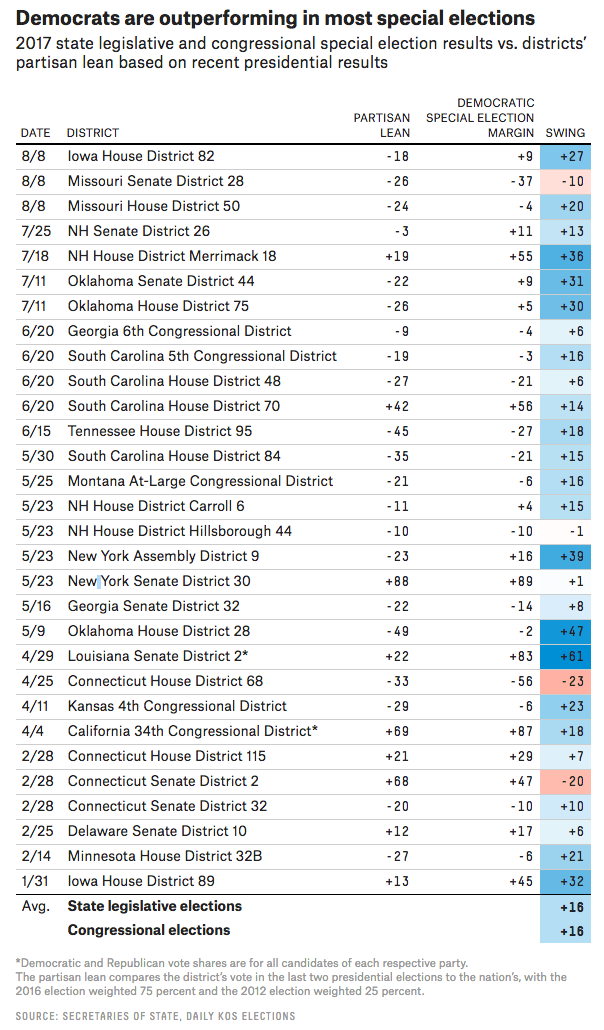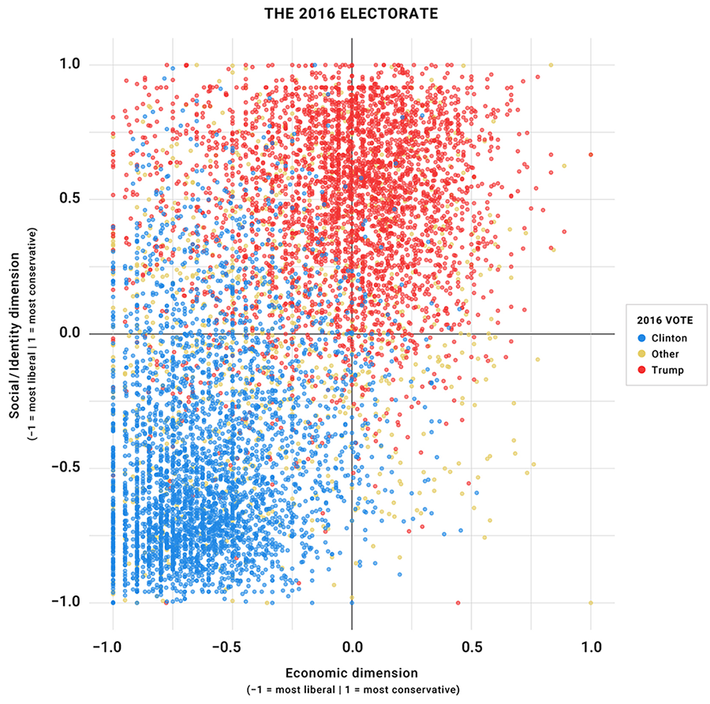
The consummate centrist Democrat lives in a tidy political universe that’s governed by a set of immutable laws:
(1) America is a center-right nation, where three-in-four voters are either moderate or conservative.
(2) Voters cast their ballots rationally, on the basis of which candidate best represents their ideologically determined policy preferences.
(3) Therefore, if Republicans are winning elections, it must be because Democrats moved too far left and alienated the moderate swing voters on whom their electoral viability depends.
This worldview has always rested on false premises. But Donald Trump’s election made its fallacies more difficult to ignore. After all, if moderate voters determine elections, then how did a a xenophobic insult-comic — who campaigned in support of political violence, religious discrimination, and mass-murdering Muslim prisoners of war with bullets dripped in pig blood — defeat a technocrat who’d campaigned as a nonideological problem-solver? And if voters are rational ideologues, then how did Donald Trump win 27 percent of whites who favored “more liberal policies” than Barack Obama had pursued? And given that the Democrat won the popular vote in 2016 — and that the election was determined by the geographic distribution of 80,000 ballots across three states — mustn’t the relationship between voter preferences and election outcomes be more complicated than this model suggests?
Alas, no amount of disconfirming evidence can shake the consummate centrist Democrat’s belief in his worldview. And it isn’t hard to see why: In the early 1990s, that worldview won said Democrat elections — and with them, fame, money, and, for a period, influence over the most powerful man in the world.
And so, our dear consummate, centrist Democrat — namely, former Clinton pollster Mark Penn — must keep the faith. He must struggle, valiantly, to bend reality into conformity with Third Way dogma, and argue for the timeless wisdom of Clintonian “triangulation” — the notion that Democrats will always benefit electorally, by adopting a kinder, gentler version of the GOP agenda.
In a recent column for the Hill, Penn tried to establish an empirical foundation for this argument in our present moment — and inadvertently exposed just how weak it truly is.
To appreciate the capacious emptiness of the case for Democrats to “triangulate” in the Trump era, observe how many fallacies Penn must posit in order to reach the conclusion that his party is recklessly ignoring the popularity of the president’s policies.
Trump must be more popular than polls suggest because Democrats have done poorly in special elections.
Polls show the president’s approval rating all over the lot. An Associated Press poll put it at 32 percent and suggests that only 24 percent see the country as going in the right direction. This strains credulity given what happened in the special elections against the Democrats.
It strains credulity that a professional political strategist actually believes that last sentence. Beyond the fact that special congressional elections are an infamously poor indicator of the national political mood (for reasons that should be obvious), Democrats have actually done historically well in elections held this year, once one accounts for the partisan tilt of the districts they’ve been held in.

Since FiveThirtyEight put together that table, Democrats have flipped state legislative seats in Florida, New Hampshire, and Oklahoma.
Trump is winning the national argument over his agenda — congressional Republicans are simply refusing to enact his policies for some unknowable reason totally unrelated to their level of popular appeal.
We see the same dynamic being played out over and over again: The president grabs the spotlight with strong statements (typically on Twitter) of his policies, for which he is savaged as over the top on social and mainstream media. Then, over time, he often wins the underlying policy argument … The remarkable thing is that, in response to a president ready to sign their legislation, the Republican leadership is committing hari-kari in failing to pass the very things that won them their elections: opposing Obamacare, enacting tax reform, taking a tougher position on Iran.
In his column, Penn does provide evidence that Trump is winning the debate on whether NFL players should stand for the national anthem. But it’s unclear how that qualifies as a “policy argument.” And when it comes to the policies that the president is actually trying to make into law, Penn fails to provide any polling data that support his premises.
This is probably because virtually no such data exists. The president’s health-care bill was the most unpopular piece of major legislation in modern American history. Polls consistently show overwhelming opposition to tax cuts for the wealthy and corporations. And recent surveys suggest that the public is aware that the Trump tax plan is composed almost entirely of giveaways to those constituencies — and not the middle class, as the president has strenuously argued.
The remarkable thing is that, in response to both reams of polling data demonstrating the unpopularity of Trump’s agenda, and a GOP majority’s persistent failure to pass that agenda, Penn concludes that all the polls are biased against Trump, and there is tremendous public support for gutting Medicaid and ending upper-middle-class tax deductions, so as to finance giant tax cuts for multimillionaires.
Totalitarian communism and revolutionary Islamism are both bad, therefore Democrats should support Donald Trump’s “tough” North Korea and Iran policies, no matter what they are.
North Korea is one of the most despotic regimes on the planet, with a ruler who hired assassins to kill his own half brother with nerve agents, uses torture and holds purges of any threats to his rule…Iran’s national anthem is “Death to America,” and no one is taking a knee to that one over there. The regime once held our embassy hostage, and 70 percent of America believes it will cheat on the nuclear arms deal. So senators who attack Trump for being too tough on these known despots and killers may get a lot of coverage but are swimming upstream, giving indirect comfort to our fiercest enemies.
Penn may be unable to discern any distinction between tweeting impulsive threats of nuclear war and “being tough” on North Korea — but the American people are. A recent Washington Post-ABC News poll found that just 37 percent of Americans trust Trump to properly handle the conflict with North Korea; 70 percent told Fox News pollsters that they found the president’s rhetoric toward the rogue state “not helpful”; and 51 percent told NPR/Ipsos that they distrust Trump’s capacity to contain Kim Jong-un’s regime.
Astoundingly, a recent poll from Harvard-Harris — the firm that Mark Penn co-directs — found that 53 percent of voters disapprove of Trump’s handling of tensions with North Korea, including 57 percent of independents.
It’s true that the Iran deal has never been popular. But it’s also true that policy toward Iran was the No. 1 issue for approximately zero percent of the electorate in 2016, and that there is near unanimous agreement among foreign policy experts — including Trump’s own military advisers — that withdrawing from the nuclear agreement would be detrimental to U.S. interests. (Further, the Iranian national anthem is not “Death to America,” and plenty of Iranians have positive feelings about the United States, which is remarkable given the fact that we helped overthrow their democratically elected leader; installed a brutal tyrant; and, thus, established the conditions that allowed religious fanatics to take over their republic.)
Trump voters weren’t attracted to his personality or demagogic style, but to his respect for cops and the military, his command of foreign policy, and his commitment to slashing federal health-care spending and taxes on the rich.
The failure to understand the 2016 election was in large measure not a failure of the final polls, many of which showed a close race, but a failure to understand the powerful storyline of Trump’s appeal with his respect for cops and the military, taking a more aggressive position against our enemies, and pushing for tax and health-care reform. His style is not what won him the presidency. It was, remarkably, his substance.
The Democratic National Convention featured about as many tributes to police and the military as it did poll-tested platitudes. It’s certainly possible that Trump enjoyed an advantage with voters who care deeply about “respect” for cops and the military. But that advantage must have been rooted in his “style” of displaying such respect (which, lets remember, included mocking American prisoners of war).
Exit polls showed that 2016 voters prefered Hillary Clinton on foreign-policy issues by an 11-point margin, so Trump’s “aggressive position against our enemies” wasn’t one of his strengths. And we’ve already discussed the unpopularity of his vision for “tax and health-care reform,” but just to underscore the point: In a recent analysis of VOTER survey (Views of the Electorate Research Survey) data, political scientist Lee Drutman found that 73.5 percent of the 2016 electorate espoused broadly left-of-center views on economic policy.

Nevertheless, Penn looks over his assemblage of demonstrable falsities and specious half-truths and concludes, “if the Democrats do cut some more deals with Trump, those deals will boost the Democrats to a major 2018 victory.”
Democrats have spent the past ten months obstructing Trump’s agenda on nearly every front — and the party currently leads the GOP in the generic congressional ballot by over 10 percentage points.
Penn does make one worthwhile point in his column: Trump tends to do much better in polls that screen for likely voters, than in ones that survey the entire adult population. This represents a strong argument for Democrats to allocate a greater portion of their resources into voter registration drives and community organizing. But the consummate centrist declines to make it.
Mark Penn will not be advising the 2020 Democratic nominee. Ever since he oversaw Hillary Clinton’s ugly failure of a 2008 campaign, his name’s been a punch line in most center-left circles. But while Penn may be irrelevant, his worldview isn’t entirely. In the House, there are 18 “Blue Dog Democrats” — a faction of centrist lawmakers who derive their name from the sentiment that liberal ideologues have “choked them blue.” And the socially liberal, fiscal centrists of the New Democrat Coalition lay claim to 61 seats. Many of these Democrats have done their darnedest to find common ground with Trump on corporate tax cuts, despite the manifest unpopularity of that policy.
Few if any of these lawmakers — or the consultants who advise them — are as deluded about the current state of American politics as Penn’s column is. But in their rhetoric and voting behavior, a good number of them affirm the consummate centrist’s fundamental premises: That Democrats are out of power because they alienated “moderates,” and thus, the party would benefit from moving its policies in the direction of the GOP’s.
Penn’s column amply demonstrates the bankruptcy of these ideas. For that reason (and no other) it deserves to be read widely.






























